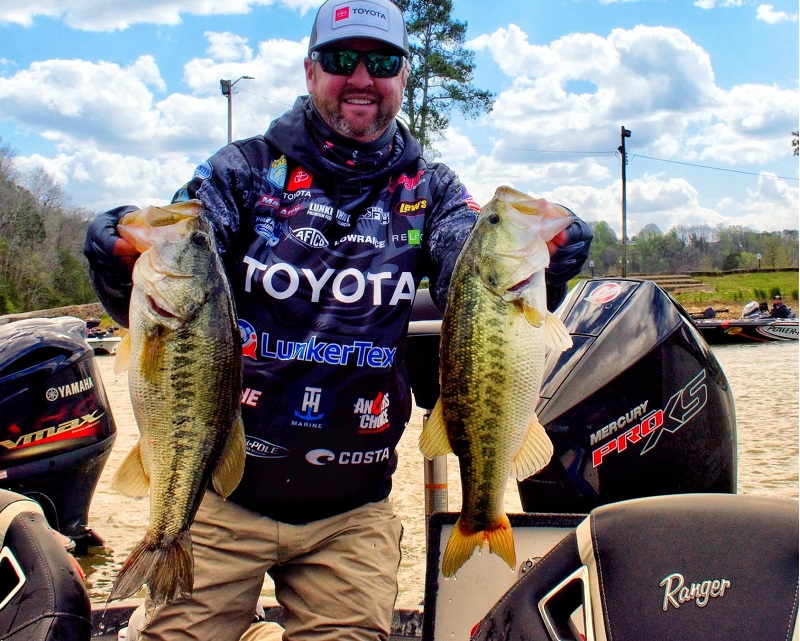
Most bass fishing talk during the spring and early summer, whether in articles like this or videos online, is on the bass spawn. The three phases of spawn are ingrained in our collective minds and pre-spawn, spawn, and post-spawn are common themes. But after they're all done, Bassmaster Elite Series pro Matt Arey shifts gears to three more spawns: shad, herring, and bluegill.
"The first thing I look for after the bass spawn is the forage spawn," said Arey. "Once the bass are done spawning, they have one thing on their mind: to feed up. When the bass are wrapped up with their spawn, the shad and herring spawn gets going first. It's a while after that when the bluegill really get going, but it's still a post-spawn bass pattern for me in shallow water."
Shad and Herring Spawns
Shad are much more prevalent in many parts of the country than the blueback herring, which is more regional, but Arey approaches them in similar ways.
"They are different species and like different places to spawn, but both can lead to some fast action for bass in the first hour or so of the day, or a little longer if you get lucky with an overcast day," said Arey. "Even after they are done actively spawning first thing in the morning, they'll hang around all day and you can still catch bass. You have to slow down and fish differently; it won't be fast and furious like the morning bite."
The key to capitalizing on the morning action is to be in the right areas where shad and herring are and that comes down to knowing where they prefer to spawn.
"Shad like rocks, riprap, marinas with floating docks, bridge pilings and other hard places close to deep water," he said. "Herring will most often be on flat points and red clay banks to spawn."
Moving baits are the way to go for the fast and furious activity and Arey will fish jerkbaits, spinnerbaits, a white Pulse Fish Lures Pro-Model Swim Jig, and a Lunkerhunt Fetch swimbait that he designed.
"That swimbait is great for tracking a few inches below the surface, and I'll fish the swim jig with a pumping action below the surface," he said. "The key with all these baits is to experiment a little with your retrieves and mix it up between the baits. The fish will position slightly differently, and it pays to vary your retrieves and depths and with different lures."
For all of these baits, Arey likes P-Line Tactical fluorocarbon. "It casts very well and has a great small diameter," he says. "I like it because it has less memory than some fluorocarbons and handles better for moving baits like these."

Bluegill Spawn
After the bass spawn, bluegill are not far away from it and they'll be spawning well into the summer. They'll use many of the same areas to spawn, but Arey will also search for them with his electronics.
"Around my house in the Carolinas, it's usually the first full moon in May that really gets it kicked off," said Arey. "I look for small pockets and protected areas protected from the wind. You can see a lot of the beds just looking around, but I'll also use my Lowrance StructureScan to idle and look for them. They'll look like little honeycombs on your graph since they spawn in groups so close together; I wish bass did that; it'd be a lot easier on us."
Topwater baits are some of Arey's top picks for targeting bass feeding on bluegill. Poppers and prop baits are two of his favorites, but he'll also mix in a subsurface approach with a wacky-rig.
For his topwaters, he likes the P-Line Topwater line in the 15-pound test. "Stealth is so important when fishing for shallow spawning bluegill," he said. "That line is great casting and you can stay back away from the fish and make long casts to them."
When fishing a wacky-rig, Arey uses a spinning outfit spooled with a 15-pound P-Line SpinX braid with a leader of 8 to 12-pound P-Line Shinsei 100% Pure fluorocarbon leader material.
"That's my line set up for anything with a spinning rod because the braid was designed for spinning and casts great without those nasty loops you get with other lines," he said. "I'll vary my leader based on the cover and water clarity. Lighter when the water is gin clear and heavier when it's more stained or if the lake is known for big bass."
After the bass spawn each season, pro angler Matt Arey switches it up and focuses on the other spawns in the lake. Knowing where to find these spawns is half the battle and picking the right lures that can effectively target bass feeding on the forage spawn is the final half of the puzzle.



 Advertising
Advertising